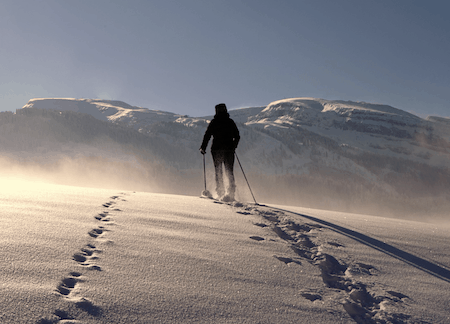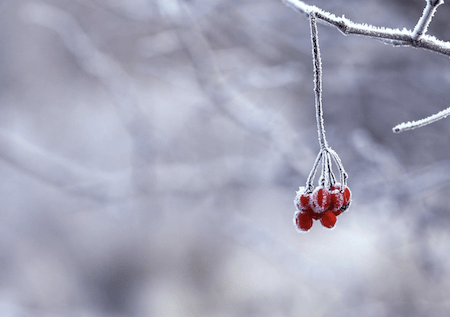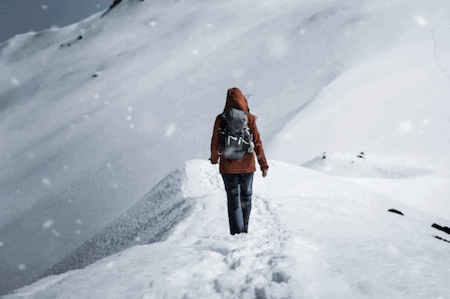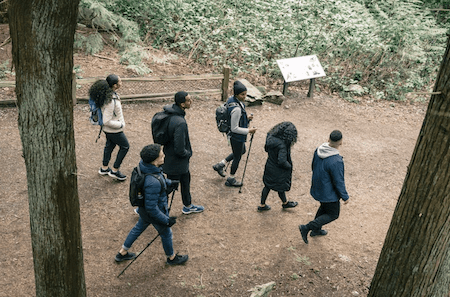Icy landscapes and quiet surroundings; these things make a winter trip even better! But it’d be best if you pack the right clothes, gear, and other essential stuff!
Let’s face it! If you forget about packing those necessary things, your winter hiking is going to be the worst!
Keep in mind, heavy snowfall and the slippery icy surface might create a lot of problems.
But no worries! Our expert team is here with the winter hiking gear checklist that’ll be effective for both hobbyists and advanced hikers.
When we talk about hiking in the winter, it becomes crucial to cover yourself from head to toe, including pants, blazers, hiking boots, mufflers, gloves, and so forth.
Let’s not forget about getting a beanie or woolen hat designed to keep your head warm in the cold season.
And yes, a first aid box, backpack, compass, and adequate food and water will be needed to make your hiking journey a lot more convenient.
In fact, we don’t want that you face any discomfort and troubles while hiking!
Table of Contents
Factors To Consider While Hiking In Winter
Believe it or not, hiking in winter can be risky, especially if you aren’t well equipped and prepared with the right stuff.
The freezing environment can behave harshly with you at any time, so you need to be fully prepared for that.
And for ensuring a wonderful hiking trip, you should turn attention to some specific factors.
#1. Maintaining Food and Water
Balancing the energy levels of our body by consuming sufficient water and food should be the first priority. It’s the most basic and core thing for your body to work appropriately in the cold season.
Many people tend to forget about drinking enough water due to the cold weather. So, the hydration process gets hampered.
Although you’re not thirsty enough, you should drink adequate amounts of water so that your temperature remains in control.
Also, keep on eating food throughout your journey as the metabolism does a great job of keeping your body warm.
On the other hand, you can consider several other aspects about maintaining food and water such as:
- Pack the foods that are hard to freeze. Energy bars, chocolate, and nuts are other snack-type foods that take a longer time to freeze.
- Don’t try to keep the water bottles outside of your backpack’s pocket. Instead, keeping the water pot inside will help you to have warm water.
- Try keeping the necessary food and water inside the bag and put it closer to your back. By doing so, you can slow down the freezing time.
- Be sure to buy a reservoir that has a proper insulation system. Also, you can look for different types of insulating accessories for the tube of the reservoir. They work great in cold conditions.
- Taking a thermos with you for a single day of hiking will be helpful to keep the water warm. Thus, you can make tea at once or drink lukewarm water.
#2. Risks In Winter Hiking
Compared to all the other seasons, hiking in winter is considered the riskiest one. Actually, the location where you intend to hike matters the most in this case.
Choosing harsh conditions with extreme cold weather can put you in a dangerous situation for hiking.
For example, hypothermia and frostbite; these dangerous conditions are the results of extreme cold weather.
Freezing the toe, ears, fingers, and similar body tissues represents frostbite. These are probably the most common symptoms that you’ll get when you go out hiking in the winter season.
Although frostbite is not life-threatening, it surely can damage the affected areas permanently. So it won’t be good to take it lightly.
On the contrary, you can have a life-threatening risk that is caused by hypothermia. So, it’s better to be serious about the symptoms of hypothermia while hiking in extremely cold weather.
The reason for hypothermia is so dangerous is that it drops your body temperature consistently low. And guess what? These two aren’t the only things that you should consider.
In fact, you’re at a big risk, too, if you aren’t able to handle the icy surface. An inexperienced hiker might get seriously injured while hiking on the ice or snow.
By the way, you can always reduce the chance of the risks by equipping the necessary gears and knowing how to utilize them correctly. So don’t worry!
#3. Hiking Clothes And Gears During Winter
Undoubtedly, there’s no better alternative than wearing proper clothes for keeping yourself dry and warm while hiking in winter.
For safety purposes, you can also carry additional gears to make your hiking safer and even better.
Surely, you can’t think of appropriate clothing without understanding the system of layering. It’s probably the best hiking system for some specific reasons.
While traveling on the trail, almost everyone likes to stay warmer by removing the extra outer layers.
Basically, the system is divided into 3 layers, such as:
-
The Outer Shell
In order to protect you from the outer side elements, this layer is useful. Also, it’s waterproof for keeping you dry.
-
Mid-Portion Of The Layer
This wool or fleece-made layer works as an insulator to keep you warmer. From fleece blazers to pullovers, there are a wide variety of different options for a mid-layer.
-
The Thermal Layer
Finally, the base of the insulating layer ensures moisture-wicking that is necessary for you to stay dry and warm.
Apart from the layers, it’s essential to look for a couple of things regarding clothes and gears for winter hiking.
#4. Researching The Weather And Trail Conditions
Before hiking in the winter, considering these things are necessary as you never know what you might face in the future.
So, before you go, make sure to pack some additional things (e.g. gaiters, crampons) to stay in a safe zone.
-
Avoid Cotton
As cotton gets wet very quickly and remains wet for a long period of time, this fabric is inappropriate for hiking in winter. Instead of cotton, synthetic-blend or merino wool might be your go-to.
-
Don’t Expose Your Skin
Try to cover up all of your skin from top to bottom, or else, you might catch a cold.
-
Consider Protection Against The Sun
The reflected rays of the sun might damage or burn your skin. So, taking protection from it is also necessary for hiking, even if it’s winter.
#4. Clothing For Winter Hiking
Before you prepare yourself for hiking, especially in winter, it’s crucial to pay a lot of attention to the clothing.
So let’s get familiar with some of the essential clothes:
-
Hiking Boots
Having a pair of waterproof, top-quality hiking boots is very important when it comes to winter hiking. It’s best to get insulated shoes if you think you’ll have to walk on snow.
Thankfully, insulated footwear is available for both below and above treeline adventures.
-
Blazer
Hands down, it’s another important thing to have for winter hiking. In this case, down blazers are much better in terms of holding the heat of your body to keep you warm.
Indeed, you’ll find a variety of downs available in the shop, and yes, you can pick them up depending on the range of temperatures.
It’s okay to carry a blazer with the outer shell, which is waterproof.
Although it won’t provide you that much warmth in the winter, however, it’s able to keep you dry and protected from the elements of winter.
And guess what? It’s also necessary to stay warm. What do you think?
-
Pant
There are mainly two different types of choices available for winter hiking, including hardshell and softshell pants.
Softshell pants, as the name suggests, are relatively softer, flexible, breathable, and might be water-resistant. But unfortunately, it’s unable to withstand heavy rainfall or wind.
In this case, choosing hardshell pants will be your smart decision. It’s windproof as well as waterproof.
If you hike in an extremely cold season, make sure to get both. Try to wear the hardshell pant over your regular hiking leggings, especially when the condition appears to be bad.
-
Hat Or Cap
Beanie or woolen hat is an essential part of winter hiking clothes. It aids in keeping your body temperature warm, especially your head, during snowfall.
And as you know, wool is a great material to retain body heat in the best way possible. These days, there are several types of beanies with different styles and weights.
So, it’s a wise decision to pick the one depending on your needs as well as temperatures.
-
Gloves
When it comes down to freezing temperature, gloves are necessary to have. Without using them, frostbite might be a threat for you, plus, the blood circulation might drop due to the extremely cold weather.
We prefer having at least 2 pairs of gloves. The first one should be used for insulation and warmth, and the second one should be equipped with a water-resisting ability for encountering heavy wind or snow.
-
Socks
A pair of heavy-duty woolen socks will come in handy for winter hiking. It’s crucial to keep your feet warm since you’ll have to walk on snow.
Maintaining blood circulation and preventing blisters will be possible by putting them on.
-
Base Layers
Thermal clothing is included here to keep you warm and dry. In general, they are manufactured with high-quality merino wool or synthetic. Besides, they aren’t that thick.
A few models have base layers or thermals designed particularly for winter hiking. And yes, it’s necessary to get both lower and upper body clothes.
-
Muffler
Guess what? The muffler is a must-have winter cloth that we all should wear in the cold season. And when we talk about winter hiking, it’s best to have at least a single one to keep your neck area warm.
We suggest having a neck warmer or a balaclava instead of regular mufflers. These are effective in terms of covering your entire neck area.
#5. A Number Of Optional Stuff
Having the following things aren’t a must, however, these will add extra convenience to your winter hiking.
-
Gaiter
Putting on gaiters in hiking might aid in keeping snow away from getting inside your shoes. They add extra layers of insulation in order to protect your lower legs and ankles.
Moreover, if you are going to a snake-prone area then a snake gaiter is a must.
-
Crampon (Shoe Spike)
When you walk on the ice or rock, having crampons or shoe spikes is a plus. They give you adequate stability so you can walk on slippery snow without having any problems and discomfort.
Before choosing crampons, make sure to look for several types to see which suits you most. It’s also necessary to consider the conditions and terrains if you want to get the right one.
-
Snowshoes
If the surface appears to be too slippery and it’s covered entirely with snow, then snowshoes are what you need to have.
It enhances your footwear’s surface area in order that you can smoothly walk on snow.
#6. Gear For Winter Hiking
Yep, not only you should have proper clothing, but also it’s important to get some of the specific gear for winter hiking. So, let’s check the following things below:
-
Backpack/Daypack
The backpack comes first when we talk about hiking gears. Since you’ll have to carry a lot of different stuff (from food to clothes), having such a bag is too important.
As you’re taking preparing for winter, it’s better to get a large-sized backpack (30L or more), so you can carry each and every essential gear with ease.
A daypack or something smaller might feel your requirements as well if you’re preparing for a short trip (1 or 2 days).
-
Water And Food
There is no need to describe the importance of food and water!
So, when you go winter hiking, be sure to have some snacks which won’t freeze in extreme cold.
As for carrying water, it’s a good idea to get drink bottles or hydration reservoirs.
-
First Aid Box
Undoubtedly, it’s a must-have winter hiking gear. Feel free to buy a kit that’s fully stocked.
Also, you can make your own by collecting medical tape, bandages, pills for pain relief, antiseptic, adhesive plasters, and sterile gauze pads.
-
Thermos
Getting a thermos is a good idea in order to keep your essential drinks and water hot. And guess what? It lets you make a cup of tea, keeping yourself warm for long in the winter hiking.
-
Compass/Map
It doesn’t matter what the season is, it’s always necessary to get a compass or map for hiking.
For more convenience, ensure to set up a GPS. A navigation system plays a significant role when the battery runs out, or technology fails.
-
Headlamp
While hiking at night, a piece of headlamp will help you a lot to walk in the dark without any risk. So try to carry at least a single head-torch with you.
-
Fire Starter and Survival Blanket
Your winter hiking might turn into a nightmare if you don’t have a fire starter and emergency blanket with you.
When the temperatures seem very low, these essential gears will assist you in keeping your whole body warm.
Also, make sure you know how to start a fire with sticks, just in case.
-
Personal Location Beacon (PLB)
Last but certainly not least, you’ll be capable of calling for rescue, especially in any emergencies through PLB.
And needless to say, a satellite phone or personal locator beacon is used in those areas where you can’t find a strong network to contact someone.
Wrapping Up!
Always make sure to have the right things with you when you prepare for winter hiking.
By putting on the right clothes and gear, you’ll be able to make your journey more fun and more enjoyable!
That’s why the write-up on the winter hiking gear checklist includes everything you need to get. And don’t forget to have adequate amounts of water and some snacks with you!
After all, proper preparation is the key to ensure an enjoyable trip!






